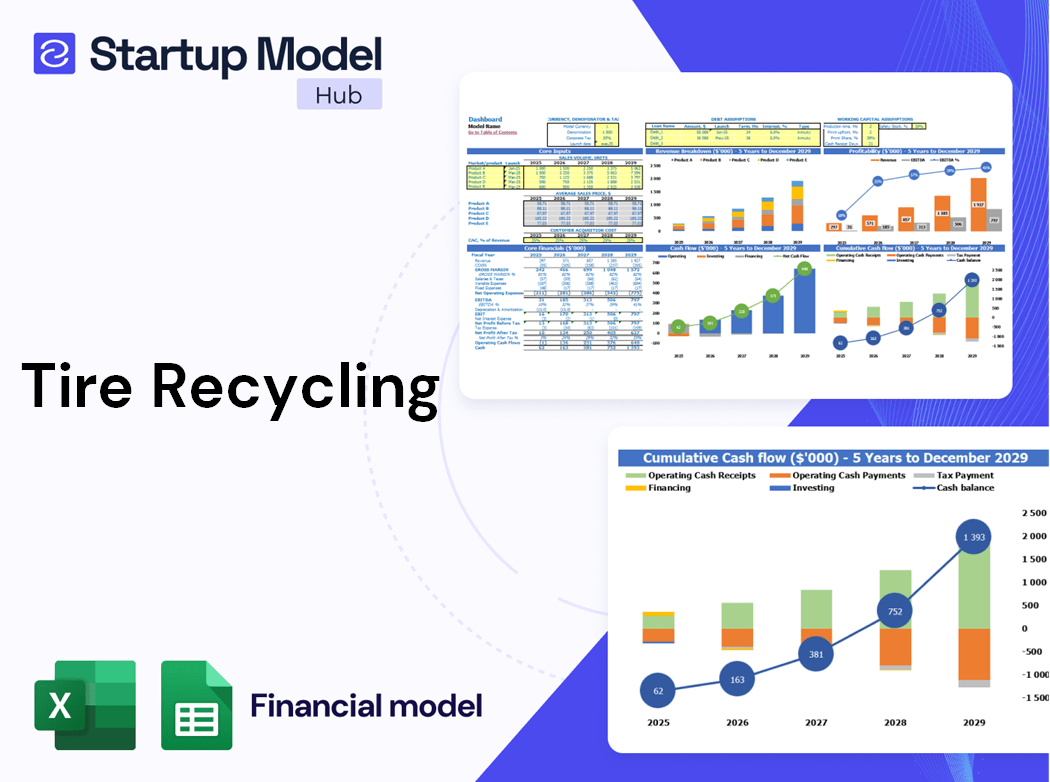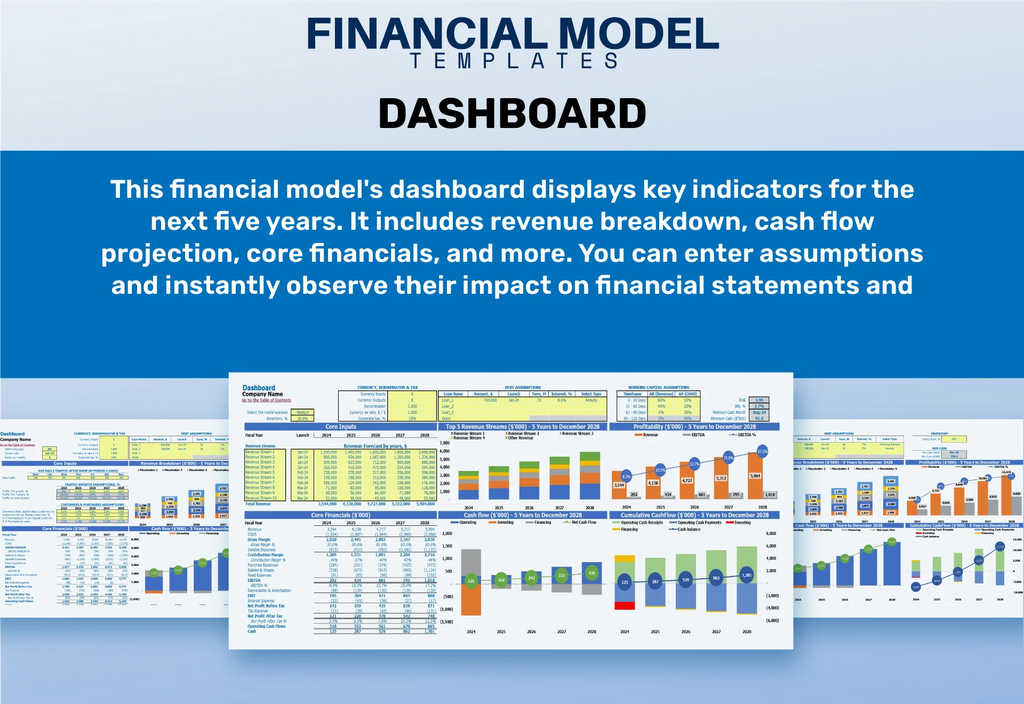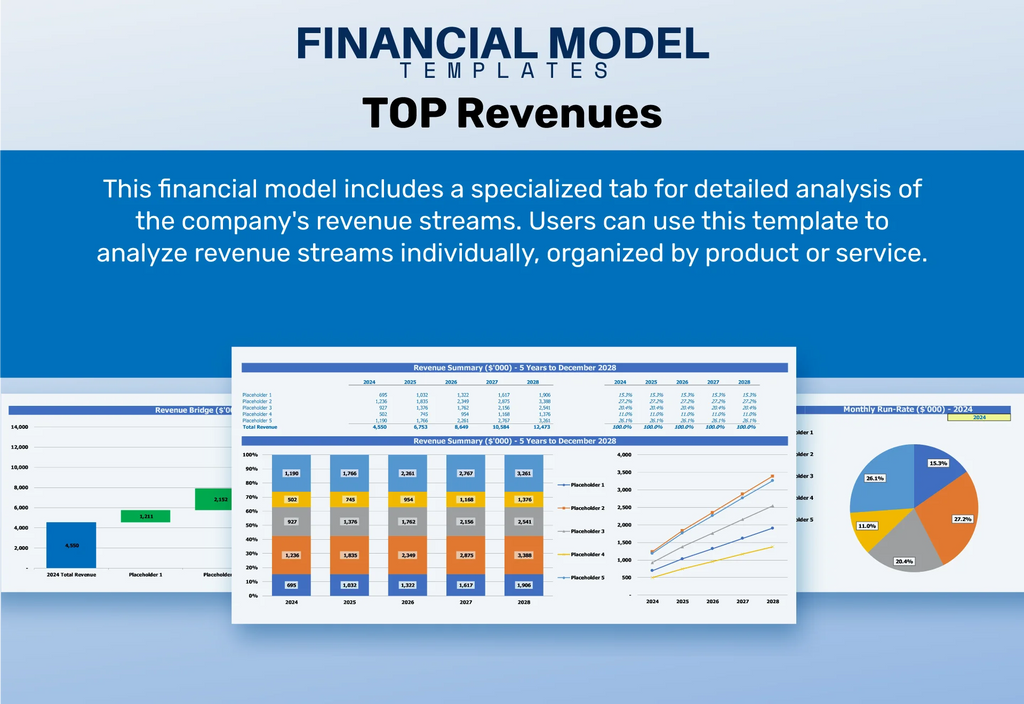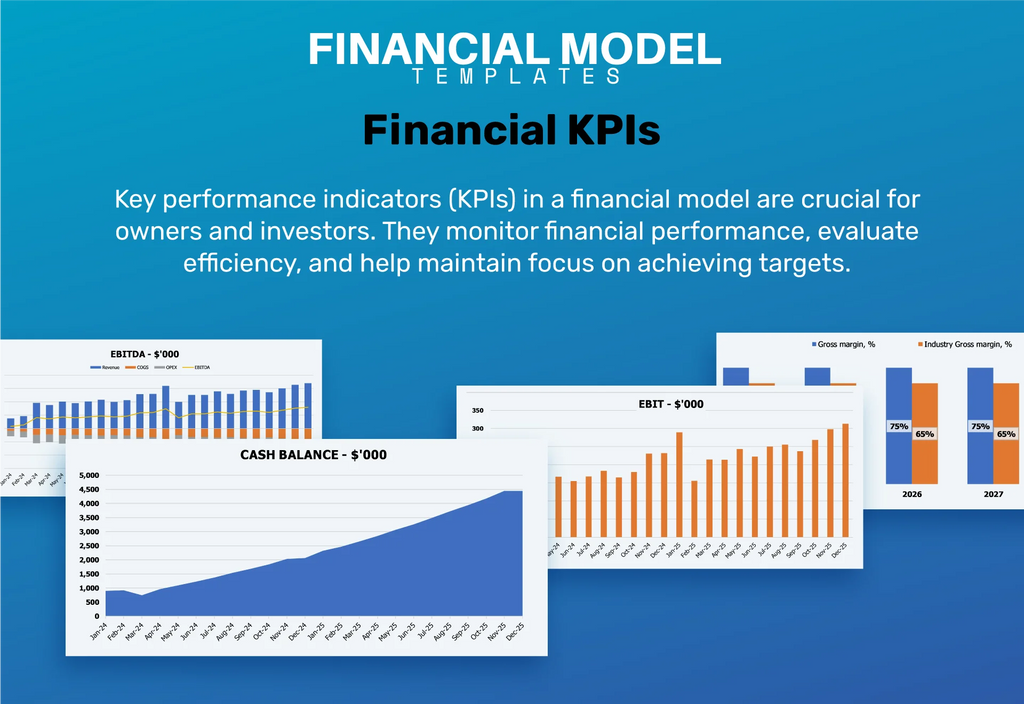Tire Recycling Financial Model

5-Year Financial Projections
100% Editable
Investor-Approved Valuation Models
MAC/PC Compatible, Fully Unlocked
No Accounting Knowledge Needed
Tire Recycling Financial Model
Bundle Includes:
-
Financial Model
-
Business Plan
-
Pitch Deck
-
Financial Dashboard
ALL IN ONE MEGA PACK - CONSIST OF:
tire recycling Financial Model/Business Plan Excel Template
Pitch Deck Template For PowerPoint, Keynote & Google Slides
Business Plan Guide and Business Plan Template in MS Word Format
Financial Dashboard in Excel To Track Your Business Performance
TIRE RECYCLING FINANCIAL MODEL FOR STARTUP INFO
Highlights
This comprehensive tire recycling business plan includes detailed financial forecasting for tire recycling operations, focusing on the cost structure and investment needed for a tire recycling facility. A thorough market analysis for tire recycling has been conducted, highlighting various revenue streams, including tire-derived fuel and recycling grants for tire businesses. The profitability analysis emphasizes profit margins and cash flow within tire recycling operations, while also addressing capital expenditure and operational costs. Additionally, a break-even analysis for tire recycling is provided alongside financial risks associated with the industry. This plan also assesses sustainability in tire recycling finance, showcasing the economic benefits of ensuring effective tire waste management through innovative tire pyrolysis financial projections. The accompanying financial model equips entrepreneurs to evaluate their startup ideas and plan costs effectively.
The tire recycling financial model template addresses several pain points for buyers by providing a comprehensive framework for financial forecasting specific to the tire recycling industry. It simplifies complex tasks such as profit and loss analysis, allowing users to identify key revenue streams and assess the cost structure associated with tire recycling operations. With built-in tools for cash flow analysis and break-even calculations, users can effectively manage operational costs and gauge profitability through detailed financial projections, including those related to tire-derived fuel. Additionally, the template guides users in understanding capital expenditure and investment needs for a tire recycling facility, enhancing decision-making capabilities, and helping to secure recycling grants and capital for technology investments, ultimately supporting sustainability goals while minimizing financial risks in tire waste management.
Description
The tire recycling financial model provides a comprehensive overview of the business's potential by offering a five-year financial forecast that includes crucial components such as profit and loss projections, balance sheets, and cash flow analysis. This tool is designed to assist in assessing the investment required for a tire recycling facility, while also analyzing operational costs and revenue streams, including tire-derived fuel and other products. With a focus on sustainability, it helps identify profit margins, financial risks, and potential recycling grants to support the venture, enabling investors to conduct market analysis for tire recycling and perform break-even analysis to determine the viability of the business. By simulating different scenarios, this model ultimately aids in making informed decisions regarding capital expenditures and financial forecasting for tire recycling, ensuring a clearer path to profitability.
TIRE RECYCLING FINANCIAL MODEL REPORTS
All in One Place
Every tire recycling venture, regardless of its scale, requires a comprehensive five-year business plan. This plan should integrate financial forecasting, including cash flow analysis and projected balance sheets, to ensure profitability and sustainability. A robust tire recycling financial model encompasses operational costs, revenue streams, and investment needs, providing a clear path to break-even and profitability. It’s crucial to assess market analysis and potential financial risks while considering grants and technology investments. Ultimately, a holistic approach to tire recycling finance will unlock economic benefits and optimize profit margins, securing a successful future in tire waste management.

Dashboard
To achieve effective financial forecasting for your tire recycling business, a comprehensive financial model is essential. An Excel template can seamlessly organize your financial data and generate pro forma balance sheets and projected profit and loss statements. By utilizing this model, clients can visualize crucial metrics through customizable graphs and charts, enhancing efficiency and clarity. Incorporating elements like cash flow analysis, cost structures, and revenue streams will ensure a robust strategy, enabling you to assess profitability, identify financial risks, and ultimately drive sustainability in your tire recycling operations.

Business Financial Statements
A comprehensive financial analysis is essential for a successful tire recycling business plan. Key components such as the profit and loss statement, projected balance sheet, and cash flow model offer crucial insights into operational performance and capital management. Understanding the cost structure of tire recycling, including operational costs and investment in technology, can enhance profitability analysis. Additionally, effective financial forecasting for tire recycling, along with break-even analysis and revenue streams from tire-derived fuel, can mitigate financial risks. By leveraging recycling grants and focusing on sustainability, the business can ensure robust cash flow and economic benefits.

Sources And Uses Statement
The "Sources and Uses of Funds" tab in the financial model provides a comprehensive overview of funding sources for your tire recycling business plan, while highlighting the strategic allocation of these funds. This detailed analysis facilitates financial forecasting for tire recycling, enabling you to identify optimal investment opportunities in technology, operational costs, and capital expenditures. By incorporating tire recycling profitability analysis, you can assess revenue streams and profit margins, ensuring sustainability and economic benefits while mitigating financial risks. This structured approach supports informed decision-making and paves the way for successful tire waste management initiatives.

Break Even Point In Sales Dollars
Understanding your break-even point in tire recycling is crucial for assessing business viability. This financial forecasting tool calculates the minimum sales needed to cover operational costs, providing clarity on profit margins and facilitating strategic decisions such as reducing unnecessary expenses. With organized financial data, you can also project when your investment in a tire recycling facility will be recouped, helping manage stakeholder expectations effectively. Additionally, this analysis supports further insights into revenue streams and cash flow, making it an essential component of your tire waste management financial model.

Top Revenue
The Top Revenue tab in the pro forma income statement Excel template provides a comprehensive overview of your tire recycling business's financial data. It details annual revenue streams, enabling you to conduct a robust profitability analysis. With a clear breakdown of revenue depth and a revenue bridge, you can effectively assess your financial forecasting, operational costs, and investment potential. This insight is crucial for ensuring sustainable cash flow in tire recycling operations and identifying market opportunities while managing financial risks effectively. Utilize this tool for informed decision-making and strategic planning in your tire recycling investment.

Business Top Expenses Spreadsheet
Effective expense tracking is essential for a thriving tire recycling business. By generating a summary cost report, you gain insights into your operational costs and financial forecasting for tire recycling. This detailed breakdown not only aids in tax preparation but also enables you to analyze actual versus planned expenses, pinpoint variances, and plan for future growth. Organized records support your investment in tire recycling technology, enhance profitability analysis, and contribute to a robust financial model. Ultimately, sound cash flow management will ensure sustainable success and maximize profit margins in your tire recycling operations.

TIRE RECYCLING FINANCIAL PROJECTION EXPENSES
Costs
Our financial projection Excel template is designed specifically for tire recycling businesses, enabling you to create a comprehensive budget and financial forecasts for up to five years. It facilitates in-depth analysis of costs, including fixed and variable expenses, payroll, and capital expenditure. Users can visualize the financial dynamics of tire recycling operations, helping to identify revenue streams and assess profitability. With features tailored for tire waste management and sustainability considerations, this tool is essential for managing cash flow and conducting break-even analysis, ensuring your investment in a tire recycling facility is both strategic and financially sound.

CAPEX Spending
This financial projection template in Excel streamlines the calculations of capital expenditures (CapEx) for your tire recycling business plan. With pre-built formulas, users can easily assess the volume of investments needed, integrating insights from profit-loss projections and projected balance sheets. This tool is essential for conducting a comprehensive profitability analysis, evaluating operational costs, and forecasting cash flow in tire recycling operations. By providing a clear financial model, it supports informed decision-making and enhances your investment strategy for a sustainable tire recycling facility. Unlock the potential economic benefits and optimize your financial plans with this resource.

Loan Financing Calculator
Monitoring loan profiles and repayment schedules is crucial for tire recycling startups. Implementing robust infrastructure and software can provide detailed insights into outstanding amounts, maturity dates, and key covenants. A well-structured loan repayment schedule should clearly outline interest expenses and principal repayments, directly influencing cash flow forecasting. It’s vital to link the closing debt balance to the balance sheet, highlighting how regular loan repayments affect overall cash flow. This transparency allows tire recycling businesses to manage financial obligations effectively, ensuring profitability and sustainability in their operations while navigating financial risks and capital expenditures.

TIRE RECYCLING EXCEL FINANCIAL MODEL METRICS
Financial KPIs
A robust financial model is essential for any tire recycling business plan, enabling you to monitor key performance indicators (KPIs) over a five-year period. Critical metrics include EBITDA/EBIT, which reflects earnings before interest, taxes, and depreciation, and cash flow analysis, detailing inflows and outflows. Additionally, tracking cash balance provides insight into projected liquidity. A thorough profitability analysis of tire recycling and understanding operational costs can enhance decision-making, ensuring sustainable financial growth and investment in tire recycling facilities. By evaluating revenue streams and conducting break-even analysis, businesses can strategically navigate financial risks and capitalize on recycling grants.

Cash Flow Forecast Excel
In the tire recycling industry, effective cash flow management is crucial for success. Utilizing cash flow analysis tools within a comprehensive financial model allows businesses to track cash movement and forecast future financial health. This is essential for optimizing capital turnover and boosting profitability. By integrating tire recycling operational costs with financial forecasting, businesses can identify revenue streams, assess financial risks, and explore investment opportunities in advanced recycling technologies. A well-structured business plan, coupled with market analysis and break-even evaluations, ensures sustainable growth and maximizes profit margins in tire recycling operations.

KPI Benchmarks
Benchmarking is essential for evaluating a tire recycling venture's performance by comparing it against industry leaders. A comprehensive financial forecasting model for tire recycling can facilitate this process, enabling users to calculate key metrics such as profit margins, operational costs, and productivity ratios. By utilizing a specialized startup pro forma template, businesses can tabulate their performance alongside competitors, enhancing visibility into financial risks and opportunities. This side-by-side analysis supports informed decision-making, ensuring alignment with best practices in tire waste management and driving sustainability and profitability in the tire recycling sector.

P&L Statement Excel
A well-structured income statement is crucial in a tire recycling business plan, as it highlights profitability by mapping out revenues, expenses, and net profit. This financial forecasting tool is essential for demonstrating the viability of the tire recycling operations, showcasing cash flow, and supporting break-even analysis. Investors and stakeholders demand rigorous financial models that detail cost structures, revenue streams, and potential profit margins. By leveraging accurate projections, including those for tire pyrolysis and derived fuel, businesses can attract investment and effectively navigate financial risks while promoting sustainability in tire waste management.

Pro Forma Balance Sheet Template Excel
The projected balance sheet for a tire recycling business plan is crucial in assessing financial forecasting and long-term viability. While investors prioritize cash flow statements to understand the flow of their investment, the balance sheet offers insights into operational effectiveness and financial health. It integrates seamlessly with income and expenditure templates, aiding profitability analysis and assessing return on equity (ROE) against capital expenditures. This comprehensive financial model supports investment decisions, providing a clear view of potential revenue streams and helping to manage financial risks in tire recycling operations, ultimately showcasing the economic benefits and sustainability in tire waste management.

TIRE RECYCLING FINANCIAL PROJECTION TEMPLATE VALUATION
Startup Valuation Model
Prepare your presentation with a comprehensive tire recycling business plan centered on robust financial forecasting. Our tire recycling financial model offers valuation templates to highlight minimum returns for stakeholders, including the weighted average cost of capital (WACC). Showcase total cash flow available for investors using our free cash flow valuation, and illustrate the value of future cash flows with our discounted cash flow template. This professional approach ensures clarity on profitability, operational costs, and investment opportunities, making your pitch compelling to potential investors interested in sustainable tire waste management.

Cap Table
A well-structured tire recycling business plan should include a comprehensive financial model that outlines cash flow, operational costs, and potential revenue streams. Conduct a profitability analysis to determine profit margins and evaluate investment needs for a tire recycling facility. Implement a break-even analysis to assess financial risks while exploring sustainability in finance and potential recycling grants. Additionally, consider tire pyrolysis financial projections and the economic benefits of tire-derived fuel. A detailed market analysis will enhance your strategic planning and attract investors to support tire waste management initiatives effectively.

KEY FEATURES
A robust financial model for tire recycling enhances profitability analysis and ensures sustainable investment decisions for future growth.
A comprehensive financial model for tire recycling empowers businesses to predict profitability and navigate investment decisions confidently.
A robust financial model enables tire recycling businesses to optimize profitability, assess risks, and maximize revenue streams effectively.
The financial model provides a solid foundation for evaluating tire recycling profitability and optimizing revenue streams effectively.
A robust **financial model for tire recycling** enhances profitability analysis, ensuring strategic investment and sustainable revenue streams for businesses.
A robust financial model enhances decision-making by identifying revenue streams and assessing profitability in tire recycling operations.
A robust financial model for tire recycling ensures sustainable profitability and supports strategic planning for future growth opportunities.
A robust financial model for tire recycling reveals growth opportunities and enhances decision-making, ensuring sustainable profitability and cash flow management.
Utilizing a tire waste management financial model enables proactive identification of cash gaps and surpluses to ensure sustainable operations.
Effective cash flow forecasting in your tire recycling financial model empowers proactive decisions to enhance profitability and growth potential.
ADVANTAGES
A comprehensive financial model for tire recycling enhances profitability analysis, enabling informed decisions and optimized investment in sustainable operations.
A comprehensive financial model for tire recycling assists in accurately forecasting profits and mitigating risks, ensuring sustainable business growth.
A robust financial model enhances investment decisions, ensuring sustainable profitability and optimal cash flow in tire recycling operations.
The tire recycling financial model streamlines forecasting, enhancing profitability analysis and ensuring sustainable investment in tire recycling operations.
The financial model for tire recycling highlights profitability potential and guides investment decisions, ensuring sustainable business growth and success.




